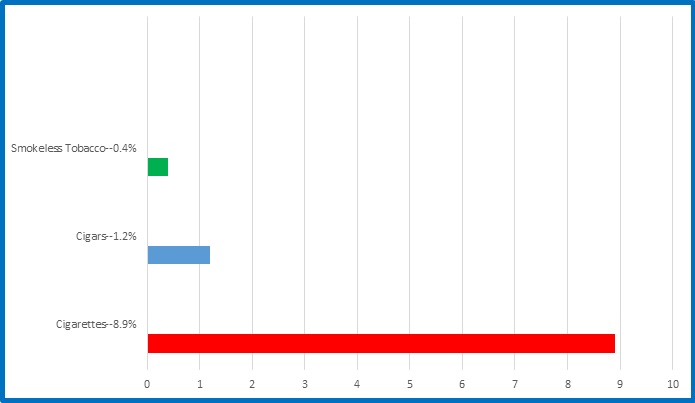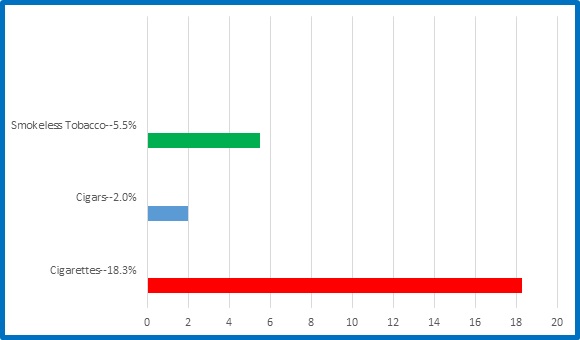Asian Americans, Native Hawaiians, or Pacific Islanders and Tobacco Use
Asian American is defined by the Office of Management and Budget as “a person having origins in any of the original peoples of the Far East, Southeast Asia, or the Indian subcontinent.”1 The six largest sub-groups of Asian Americans are from China, the Philippines, India, Korea, Vietnam, and Japan.2
Native Hawaiian or Other Pacific Islander is defined as “a person having origins in any of the original peoples of Hawaii, Guam, Samoa, or other Pacific Islands.”1
There were over 16.6 million Asian Americans in the United States in 2016—approximately 5.2% of the total U.S. population. Native Hawaiians or Other Pacific Islanders made up 0.2% of the population in 2016.3
Although Asian Americans, Native Hawaiians, and Pacific Islanders (AA/NH/PI) are often combined together as one group in survey data due to smaller numbers of the individual groups surveyed, they are actually three distinct groups.
Cigarette smoking among Asian American/Pacific Islander adults is lower than other racial ethnic groups.4 However, prevalence among Asian sub-groups varies and can be higher than that of the general population.5

Current Tobacco Use* Among Asian American Adults+6

Current Tobacco Use* Among Native Hawaiian/Pacific Islander Adults+6

By sub-groups, prevalence of cigarette smoking among Asian Americans varies considerably:5
| Asian Sub-Group | Cigarette Smoking Prevalence§5 |
|---|---|
| Chinese | 7.6% |
| Asian Indian | 7.6% |
| Japanese | 10.2% |
| Filipino | 12.6% |
| Vietnamese | 16.3% |
| Korean | 20.0% |
* “Use” is defined as self-reported consumption of cigarettes, cigars, or smokeless tobacco in the past month.
† Data taken from the National Survey on Drug Use and Health (NSDUH), 2016, and refer to Asian American adults aged 18 years and older.
§ Data taken from NSDUH, 2010–2013, and include persons aged 18 years and older who reported smoking cigarettes during the past month.
The three leading causes of death among AA/NH/PI are cancer, heart disease, and stroke,7 all of which can be caused by cigarette smoking.
- Lung cancer is the leading cause of cancer death among AA/NH/PI.8 Within this population—
- Hawaiian men and women have the highest rates of lung cancer deaths.8
- Filipino men and women have the lowest rates of lung cancer deaths.8
Cigarette smoking varies by AA/NH/PI sub-groups as a result of a number of cultural, social, environmental, and individual factors.8
- In general, Asian Americans and Pacific Islanders tend to be light, non-daily smokers.9
- One study among Asian American and Pacific Islander college students in California showed that:
- 48% of current smokers smoke cigarettes on fewer than 2 days per month.9
- 46% of current smokers smoke less than 2 cigarettes per day.9
- Cigarette smoking during pregnancy is less common among Asian American/Pacific Islander women compared to other racial/ethnic groups.10
- Among Asian American current daily cigarette smokers aged 18 years and older:
- 69.6% report that they want to quit compared to 72.8% of African Americans, 67.5% of Whites, 67.4% of Hispanics, and 55.6% of American Indians/Alaska Natives.11
- 69.4% report attempting to quit during the past year compared to 56.2% of Hispanics, 63.4% of African Americans, and 53.3% of whites.11

Tobacco companies have been creative in their efforts to reach different racial/ethnic groups. AA/NH/PI smokers are a key market for tobacco companies since cigarette smoking prevalence in most Asian countries is considerably higher than in the U.S.8,12
- The tobacco industry has sponsored Chinese New Year and Vietnamese New Year festivals and other activities related to Asian/Pacific American Heritage Month.12
- Tobacco advertisements on billboards and in stores are more plentiful in predominantly urban Asian American communities than in other urban neighborhoods.12
- Tobacco companies promote themselves among Asian American business owners by supporting their business associations and offering special retail sales materials.12

Culturally appropriate anti-smoking health marketing strategies and mass media campaigns like CDC’s Tips From Former Smokers national tobacco education campaign, as well as CDC-recommended tobacco prevention and control programs and policies, can help reduce the burden of disease among the Asian American/Pacific Islander/Native Hawaiian population.
The Asian Smokers’ Quitlineexternal icon offers free telephone counseling, self-help materials, nicotine patches, and online help in four Asian languages—Cantonese, Mandarin, Korean, and Vietnamese.
Fact Sheets and Guides
Websites
Special Publication
Disparities in Adult Cigarette Smoking—United States, 2002–2005 and 2010–2013
Although cigarette smoking has declined significantly since the release of the 1964 Surgeon General’s Report on Smoking and Health, disparities in tobacco use varies among racial/ethnic populations. Moreover, estimates of U.S. adult cigarette smoking and tobacco use are usually limited to aggregate racial or ethnic population categories (non-Hispanic whites (whites), non-Hispanic blacks or African Americans (blacks), American Indians and Alaska Natives (AI/ANs), Asians, Native Hawaiians or Pacific Islanders (NHPI), and Hispanics/Latinos; these estimates can mask differences in cigarette smoking prevalence among sub-groups of these populations.
- Government Printing Office. Revisions to the Standards for the Classification of Federal Data on Race and Ethnicity, 1997 pdf icon[PDF–156 KB]external icon. [accessed 2018 Jun 12].
- Reeves TJ, Bennett CE. We The People: Asians in the United States pdf icon[PDF–479 KB]external icon. Washington, D.C.: U.S. Department of Commerce, Economics and Statistics Administration, U.S. Census Bureau, 2004 [accessed 2018 Jun 12].
- U.S. Census Bureau. American Fact Finder, 2016. American Community Survey Demographic and Housing Estimatesexternal icon. [accessed 2018 Jun 12].
- Centers for Disease Control and Prevention. Current Cigarette Smoking Among Adults—United States, 2005-2013. Morbidity and Mortality Weekly Report 2014:63(47);1108–12 [accessed 2018 Jun 12].
- Centers for Disease Control and Prevention. Disparities in Adult Cigarette Smoking—United States, 2002-2005 and 2010-2013. Morbidity and Mortality Weekly Report 2016;65(30) [accessed 2018 Jun 12].
- Substance Abuse and Mental Health Services Administration. Results from the 2016 National Survey on Drug Use and Health: Detailed Tables pdf icon[PDF–35 MB]external icon. Rockville, MD: Substance Abuse and Mental Health Services Administration, Center for Behavioral Health Statistics and Quality, 2016 [accessed 2018 Jun 12].
- Heron, M. Deaths: Leading Causes for 2010 pdf icon[PDF–5.08 MB]. National Vital Statistics Reports, 2013;62(6) [accessed 2018 Jun 12].
- U.S. Department of Health and Human Services. Tobacco Use Among U.S. Racial/Ethnic Minority Groups—African Americans, American Indians and Alaska Natives, Asian Americans and Pacific Islanders, Hispanics: A Report of the Surgeon General. Atlanta: U.S. Department of Health and Human Services, Centers for Disease Control and Prevention, National Center for Chronic Disease Prevention and Health Promotion, Office on Smoking and Health, 1998 [accessed 2018 Jun 12].
- Romero DR, Pulvers K. Cigarette Smoking Among Asian American and Pacific Islander College Students: Implications for College Health Promotion. Health Promotion Practice 2013;14(Suppl 1):61S–9S [cited 2018 Jun 12].
- Centers for Disease Control and Prevention. Trends in Smoking Before, During, and After Pregnancy—Pregnancy Risk Assessment Monitoring System, United States, 40 Sites, 2000–2010. Morbidity and Mortality Weekly Report, 2013:62(SS06):1–19 [accessed 2018 Jun 12].
- Centers for Disease Control and Prevention. Quitting Smoking Among Adults — United States, 2000–2015. Morbidity and Mortality Weekly Report, 2017;65(52):1457-64 [accessed 2018 Jun 12].
- National Cancer Institute. The Role of the Media in Promoting and Reducing Tobacco Useexternal icon. Smoking and Tobacco Control Monograph No. 19, NIH Pub. No. 07-6242, June 2008 [accessed 2018 Jun 12].
For Further Information
Centers for Disease Control and Prevention
National Center for Chronic Disease Prevention and Health Promotion
Office on Smoking and Health
E-mail: tobaccoinfo@cdc.gov
Phone: 1-800-CDC-INFO
Media Inquiries: Contact CDC’s Office on Smoking and Health press line at 770-488-5493.


